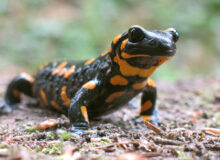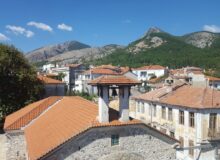The See Greece guide to the island of Karpathos with a brief history and travel information on how to get there by ferry or by air and what to see and do.

Introduction to Karpathos
Karpathos is the second-largest island in the Dodecanese, located between Crete and Rhodes in the southeastern Aegean Sea. Known for its rugged landscapes, pristine beaches, and traditional villages, Karpathos offers a blend of natural beauty and authentic Greek culture. Unlike some of its more tourist-heavy neighbors, the island retains a sense of unspoiled charm, making it ideal for travelers seeking both relaxation and adventure.
This guide covers everything you need to know about Karpathos, including its history, top attractions, the best time to visit, and how to get there by air and ferry.
Where Is Karpathos?

Karpathos sits in the southern part of the Aegean Sea, roughly halfway between Rhodes and Crete. It belongs to the Dodecanese island group, which also includes popular destinations like Kos and Symi. The island is long and narrow, stretching about 50 km (31 miles) from north to south, with a mountainous interior and stunning coastal scenery.
The capital, Pigadia (also called Karpathos Town), is located on the southeastern coast and serves as the main port and administrative center. Nearby islands include Saria (an uninhabited islet to the north) and Kasos (a smaller island to the southwest).
A Brief History of Karpathos
Karpathos has a rich history shaped by various civilizations over the centuries.
– Ancient Times: The island was known in antiquity as Karpathos and was mentioned by Homer in the Iliad as part of the Greek alliance during the Trojan War. It was influenced by the Minoans, Mycenaeans, and later the Dorians.
– Roman & Byzantine Rule: The Romans controlled the island before it became part of the Byzantine Empire. Several early Christian basilicas from this period can still be seen.
– Venetian & Ottoman Periods: Like much of the Dodecanese, Karpathos was occupied by the Venetians before falling under Ottoman rule in the 16th century. The Ottomans dominated for nearly 400 years, leaving some cultural influences.
– Italian Occupation & Modern Era: After the Balkan Wars, Italy took control in 1912. The island finally reunited with Greece in 1948. Today, Karpathos retains strong cultural traditions, particularly in the northern villages.

What to See and Do on Karpathos
1. Explore Pigadia (Karpathos Town)
The island’s capital is a lively hub with a scenic harbor, tavernas, and shops. Key attractions include:
– Archaeological Museum: Displays artifacts from ancient Karpathos.
– Vroukounda Beach: A quiet beach just south of town.
– The Old Town: Features charming alleyways and traditional houses.

2. Visit Olympos – The Traditional Mountain Village
Perched in the northern mountains, Olympos is one of Greece’s most preserved traditional villages. Known for its colorful houses, windmills, and local customs, it offers a glimpse into authentic island life. Don’t miss:
– Women in Traditional Dress: Many locals still wear handmade embroidered clothing.
– Local Bakeries: Try makarounes (homemade pasta) and other regional specialties.

3. Discover Stunning Beaches
Karpathos boasts some of the best beaches in the Dodecanese:
– Apella Beach: A postcard-perfect cove with turquoise waters and pine trees.
– Kyra Panagia: A secluded beach with golden sand and clear water.
– Achata Beach: A quieter option with pebbles and excellent snorkeling.
– Diakoftis: A remote, white-sand beach with shallow waters.
4. Hike the Trails & Explore Nature
The island’s rugged terrain is ideal for hiking:
– Mount Kali Limni: The highest peak (1,215m) offers panoramic views.
– Olympos to Avlona Trail: A scenic route through traditional villages.
5. Take a Boat Trip to Saria Island
This uninhabited isle north of Karpathos is perfect for adventurers:
– Palatia: Ancient ruins believed to be a Byzantine settlement.
– Crystal-clear waters: Ideal for swimming and snorkeling.
6. Experience Local Festivals & Music
If visiting in summer, don’t miss:
– Panagia Festival (August 15th): Celebrated with music, dancing, and feasting.
– Traditional Karpathian Music: Live performances often feature the lyra (a Cretan violin-like instrument).

Best Time to Visit Karpathos
The ideal time to visit depends on your preferences:
– June to September: Peak season with warm weather (25–35°C / 77–95°F), perfect for beachgoers. July and August are the busiest months.
– May & October: Shoulder season with fewer crowds, pleasant temperatures, and lower prices.
– Winter (November–April): Quiet, with some businesses closed, but great for solitude and hiking.

How to Get to Karpathos
By Air
– Karpathos National Airport (AOK): Located near Pigadia, it receives seasonal flights from Athens (1-hour flight) and international charters from Europe (mainly Germany and the UK).
– Connections via Rhodes or Crete: If no direct flights are available, fly to Rhodes or Heraklion (Crete) and take a ferry.
By Ferry
Karpathos is well-connected by ferry, especially in summer:
– From Piraeus (Athens): Overnight ferries (12–15 hours) run weekly.
– From Rhodes: Regular ferries (3–5 hours) via Blue Star Ferries and ANEK Lines.
– From Crete (Sitia or Heraklion): Seasonal routes (5–7 hours).

Final Tips for Visiting Karpathos
– Rent a Car or ATV: Public transport is limited, so renting a vehicle is the best way to explore.
– Respect Local Traditions: Especially in Olympos, where customs are deeply valued.
– Pack for the Sun: Bring sunscreen, a hat, and plenty of water for outdoor activities.





















